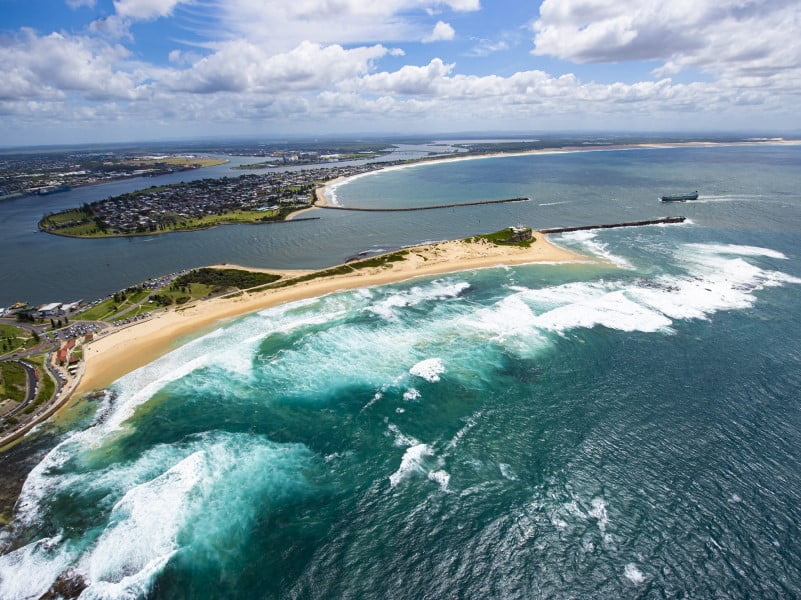A green hydrogen and ammonia production joint venture between the Port of Newcastle, Macquarie Capital, and Macquarie’s Green Investment Group has been cancelled, releasing a $41 million federal grant commitment.
The stage one 40MW electrolyser and accompanying ammonia production plant, dubbed H2Newcastle, was deemed “technically feasible but not commercially viable” according to a Port of Newcastle spokesperson.
It was originally intended to scale to 1GW, enough to produce 150,000 tonnes of hydrogen per annum.
A Macquarie spokesperson declined to comment on “specific projects involving other parties” but highlighted “the changing economics of hydrogen projects around the globe following measures announced in the US Inflation Reduction Act (IRA) has been well documented over recent months”.

“While we wouldn’t comment on specific projects involving other parties, Macquarie remains a global leader in its commitment to developing early-stage green hydrogen projects as a key companion to renewable energy and one of the cleanest and most effective forms of firming grid power,” the spokesperson said.
The partnership between Macquarie Green Investment Group and the PoN dissolved in October 2022, the same month that the $41 million grant was formally declined. Macquarie Asset Management remains invested in the PoN, which began in 2018.
Department of Climate Change, Energy, Environment, and Water (DCEEW) confirmed that “no grant agreement under the [hydrogen hub] program was executed between the Port of Newcastle and the department, and no grant funds were paid”.
The $3 million stage one feasibility study, which was funded in half by the Australian Renewable Energy Agency (ARENA), took place between November 2021 and May 2022.
Other partners to the study included Lake Macquarie City Council, Idemitsu Renewable Developments Australia, Snowy Hydro, Jemena Gas Networks (NSW), Keolis Downer, and Macquarie Agriculture.
Former Energy minister Angus Taylor announced $41 million in grant support for the project through the former Department of Industry, Science, Energy, and Resources’ Regional Hydrogen Hubs Program in April 2022.
The $526 million Regional Hydrogen Hubs Program program has been renamed as the ‘Australian Clean Hydrogen Industrial Hubs Program’ and is now administered by the DCEEW.
Work on a 220 hectare common-use and shared infrastructure Clean Energy Precinct at the PoN is still proceeding. A $100 million grant through the Department of Infrastructure for the precinct was announced as received in the March 2022-23 federal Budget.
Federal and state energy ministers on Friday agreed to undertake a review of the national hydrogen strategy to ensure it “positions Australia on a path to be a global hydrogen leader by 2030 on both an export basis and for the decarbonisation of Australian industries”.
In particular, the strategy will consider the impact of the United States’ Inflation Reduction Act (IRA), which includes US$369 billion for ‘energy security and climate change’ activities and a US$3 per kilogram hydrogen production tax credit.
Climate Change and Energy minister Chris Bowen declined to respond to specific questions about H2Newcastle but described the IRA as “a game-changer for climate action and for clean energy supply chains, including hydrogen”.
“The strategy refresh will help Australia respond and react to the rapidly developing hydrogen industry. Australia has the resources, technical skills and track record with international partners to become a global hydrogen leader,” Mr Bowen told InnovationAus.com.
“The Department of Climate Change, Energy, the Environment and Water is still negotiating grant agreements with other Hydrogen Hub proponents including the other Hunter Valley Project, led by Origin Energy Future Fuels.”
Former chief scientist and incumbent special adviser on low emissions technology Dr Alan Finkel has stated that Australia “can’t match these international subsidies on an absolute dollar basis”, so should focus on exporting value-added hydrogen products like green iron and synthetic jet fuel.
Australia’s pipeline of hydrogen investments has a higher total cost than any other resources and energy development pipeline. However, the global Hydrogen Council highlights that actual deployment is lagging with just 10 per cent of the roughly 680 large-scale hydrogen project proposals across the world having reached final investment decision.
As development on the Clean Energy Precinct continues, the PoN spokesperson said the port “remains strongly of the view that hydrogen and ammonia will play a major role in Australia’s transition to a clean energy economy”.
Estimated to involve more than $750 million in expenditure, the precinct will “involve installing Australia’s biggest private power network and support the production, storage, distribution and export of hydrogen as well as ammonia, methanol, sustainable aviation fuels and other fuels”.
It is expected to support 3GW of renewable energy capacity and green hydrogen and ammonia production by 2025, reaching 1.6GW in five years. PoN also estimates that it will create more than 5,800 jobs by 2031, and increase the gross regional product of the Hunter by $4.2 billion.
The PoN spokesperson noted several ongoing clean energy projects in the Lower Hunter area, such as the 700MW Waratah Super Battery and AGL’s Hunter Energy Park earmarked for the Liddell power station site, that will “intersect with the Port of Newcastle in some capacity”.
“Port of Newcastle is advancing the enablement of its Clean Energy Precinct which will see the Port support all hydrogen and clean energy projects in the Hunter by providing land, utilities, storage, transport and export infrastructure and services, rather than acting as the proponent.
“With an existing deep-water shipping channel, strong industry partnerships, proximity to existing demand and access to global energy export routes, Port of Newcastle is the ideal location to develop a fully integrated clean energy hub and export industry expansion.”
Do you know more? Contact James Riley via Email.

